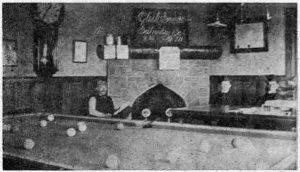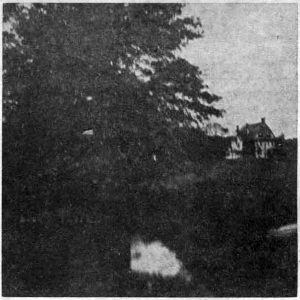During the past week there has come into the temporary possession of your columnist a book of priceless old pictures of Wayne of the 1900’s, lent to her by George W. Schultz.
Mr. Schultz first came to Wayne in 1888, when his father and mother, Mr. & Mrs. G.H. Schultz, with their four children, settled in the 200 block on Walnut avenue, in one of the first houses built by the Wayne Estate. Now Mr Schultz is again making his home in Wayne, after an absence of some years.
The pictures show a number of Wayne’s landmarks in the way of the early homes, buildings and outdoor scenes and are beautiful examples of photography. All were taken by Mr. Schultz, who has preserved them so carefully that they are clear in every detail. From time to time various of these pictures will be reproduced in this column.
 The first of the two pictures this week is an interior view of the Merrivale Club and the second is one of Kelly’s Dam, with the John P. Wood house on the corner of Walnut avenue and Radnor road shown in the distant background.
The first of the two pictures this week is an interior view of the Merrivale Club and the second is one of Kelly’s Dam, with the John P. Wood house on the corner of Walnut avenue and Radnor road shown in the distant background.
In the spring of 1949, when this column was just getting under way, descriptions of the clubs and the dam were presented, based on articles written by Mr. Schultz. It is interesting now to turn back to these early columns for a brief resume of the stories of both the club and of the dam.
The Merrivale Club played an important part in the annals of Wayne’s early sports and recreation. The first clubhouse was a frame building situated near the railroad in North Wayne. In its early days it had a baseball diamond and two tennis courts outside, with rooms for billiards and bowling inside. Among the members were Robert Hare Powel, Jack Claghorn, Morris Wetherill, Frank Howley and George and William Schultz.
Some of the Merrivale Club members also formed a group called “The Walkers”, who took early Sunday Morning hikes. In addition to those already named, the group had among its members David Knickerbocker Boyd, later a well known architect; Billy Brown, son of the publisher of the “Wayne Times”; Charles Gleason, Lee Harrison and Bill Everly.
After this first clubhouse was destroyed by fire, activities were resumed in a building on the Francis Fenimore property in St. Davids. This was called the Radnor Cricket Club, since interest in the game of cricket had by this time succeeded that in other and older sports. By this time Philadelphia was the center of this new English game in the United States, and for several years matches were played at the Radnor Cricket Club with other teams in the Philadelphia area. Tom Credican was the professional for the local team, which was so good that one season they won all matches except that against the Merion Cricket Club.
After a time, interest in the English game waned, and local activities ceased after this clubhouse also burned to the ground. Golf superseded cricket, and the St. Davids Golf Club, one of the oldest institutions of its kind in the United States, was formed.
Meanwhile two other sports had been flourishing – bicycling and swimming. The bicycle craze struck Wayne in the late 90’s, and a bicycle club was formed on the pike in South Wayne. Karl, the German steward, provided excellent meals for club members and their guests, before many a long bicycle jaunt.
 The picture of Kelly’s Dam shown in this column was taken in its early days, when it was merely a body of water down in a hollow in the general vicinity of what is now Willow avenue. Later, an interested group rented the rights to the dam and began to make some improvements. A dressing room was built on piles and equipment included diving boards and a slide. It was enclosed by a high wooden fence with a boardwalk along one side, and there was a filtering system to keep the water clean.
The picture of Kelly’s Dam shown in this column was taken in its early days, when it was merely a body of water down in a hollow in the general vicinity of what is now Willow avenue. Later, an interested group rented the rights to the dam and began to make some improvements. A dressing room was built on piles and equipment included diving boards and a slide. It was enclosed by a high wooden fence with a boardwalk along one side, and there was a filtering system to keep the water clean.
In winter, when the pool froze over, there was skating by lantern light, with a stove for heat in the small clubhouse. Summer activities were under the supervision of Kistler, then swimming coach, who later became an instructor at the University of Pennsylvania. From time to time swimming meets were held that were quite large, considering the size of Wayne.
In the light of present day methods of teaching swimming, those of an earlier period are interesting by way of contrast. A telegraph pole was sunk in the ground at each end of the pool, with a heavy wire cable stretched between. To this was added a rope on a pulley wire with a belt attached at the water line. The candidate for swimming lessons was strapped into the belt and thus taught the art without danger of going down.
Among the early members of the swimming club were the Wendells, the Heilners, the Spiers, the Conkles, the Hallowells, the Fulweilers, the Reginald Harts, the Canizares, Frederick Jones, Louis Erben, Charlie Maguire, the large John P. Wood family, and many others.
In time Fenimore’s Pond in St. Davids replaced Kelly’s Dam in popularity. “Billy Pump”, so named because he ran the pumping station for the Pennsylvania Railroad, was in charge here. Though he could not swim a stroke himself, Billy patrolled the pond in his rowboat so conscientiously that he never had a drowning. Both Kelly’s Dam and Fenimore’s Pond were the scenes of numerous baptisms. Indeed, it is said that the crowd at the former place on one occasion was so great that the boardwalk gave way and some of the spectators were tumbled into the water.
So much for early day sports in Wayne as brought to mind by these pictures of the Merrivale Club and of Kelly’s Dam.
